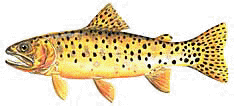|
1. ANTIMONY CREEK,
Garfield County. This clear, cold-water stream is located southeast
of Otter Creek Reservoir and the town of Antimony. The fishable
portion is located on the Dixie National Forest. It is accessible
by dirt road from the mouth of the canyon for several miles and then becomes
accessible by foot trail along most of its length. It is populated
primarily with wild rainbow trout, although the lower section contains
some brown trout.
2. BEAVER CREEK,
Piute County. This stream flows off the east side of the Tushar
Mountains and is accessible by dirt road going west from the Town of Marysvale.
It is located on the Fishlake National Forest and contains rainbow trout
and a few cutthroat trout. Some hatchery rainbow are stocked in
the more accessible and heavily used areas.
3. BOX CREEK, Piute
County. Rainbow trout and brook trout are found in this Monroe Mountain
stream. It is located on the Fishlake National Forest. Good
access is available from the bottom end of the canyon near the small community
of Greenwich.
4. BULLION CREEK,
Piute County. Very similar to Beaver Creek, this Tushar Mountain
stream is also located near the town of Marysvale. It contains rainbow
and cutthroat trout. A dirt road follows the lower end of the stream.
Some hatchery rainbow trout are stocked near a popular picnic area that
was once a historic gold mining town. The upper reaches of the stream
are accessible only by hiking.
5. COTTONWOOD CREEK,
Piute County. This stream flows off the east side of the Tushar
Mountains not far from Piute Reservoir. The lower half of the stream
is accessible by dirt road, while the upper reaches can be accessed by
hiking. The stream contains wild cutthroat trout. Most of
the stream is located on the Fishlake National Forest.
6. MANNING CREEK,
Piute County. This stream flows off the west side of the Monroe
Mountain, just a few miles south of the town of Marysvale. Manning
Meadow Reservoir and Barney Reservoir are located on branches of the stream
at the very headwaters. Both of the reservoirs and the stream are
managed with native Bonneville cutthroat trout. The entire fishable
portion of stream is located on public lands, which include the Fishlake
National Forest, BLM, and Division of Wildlife Resources property.
The stream was renovated in 1996 to remove nonnative trout and restocked
with native cutthroat trout. It will take several years for these
fish to reach full size and become abundant throughout the stream.
Vehicle access is available to the stream by dirt road at the mouth of
the canyon on BLM lands. The remainder of the stream (about 8 miles)
can be accessed by hiking along a trail system. Catch and release
fishing is recommended.
Utah's Wild Trout
Brown trout -- are native
to Europe and western Asia. They were introduced into the United
States in the late 1800's. They seek overhead cover and dark shady
places in streams. They have a reputation of being hard to catch,
but are most vulnerable to angling in small streams. They tolerate
lower elevation areas and warmer water better than most other trout
 Brown trout
Brown trout
Rainbow trout -- are
native to the west coast of North America and have been introduced into
Utah. They are widely produced in both public and private hatcheries,
but wild populations thrive in small streams. They often feed in
open pools and runs which makes them susceptible to a well presented fly
 Rainbow trout
Rainbow trout
Brook trout -- are native
to the eastern United States and Canada, and are actually members of the
char family rather than a true trout. They can become abundant in
cold streams and spring creeks, especially in headwater areas and are
usually less abundant in lower, warmer portions of streams. They
are known for their brilliant coloration.
 Brook trout
Brook trout
Cutthroat trout -- are
the only trout native to the intermountain west and are often called "natives"
by local fishermen. A number of subspecies are recognized from different
geographic areas of the west. Bonneville cutthroat trout and Colorado
River cutthroat trout are both native to southern Utah, and are still
found in some streams in the Bonneville basin and the Colorado River basin,
respectively. Large numbers of cutthroat trout do not tolerate competition
with other trout very well and are easily displaced. They are susceptible
to over-fishing and can hybridize with rainbow trout.

Bonneville cutthroat

Colorado River cutthroat
Fish of Utah
- Species Identification
Visit the Utah Fisheries Information Page
Visit the
Utah Wildlife Resources Home Page
We would like to thank the Utah Division of Wild Life Resources for
allowing us to use content from their website and would encourage you
to visit them at
http://wildlife.utah.gov/
for more information on Utah's vast wildlife resources.
|